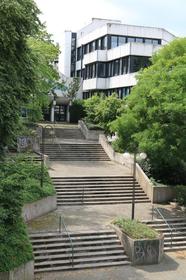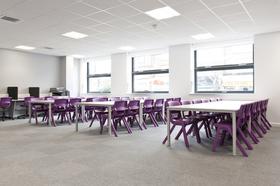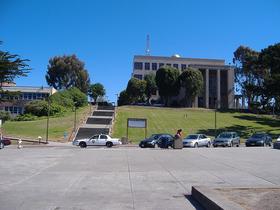- Our mission as a comprehensive community college is to provide you with the highest quality learning opportunities. Nash Community College now offers 68 degree, diploma, or certificate options, as well as a wide variety of professional development continuing education courses.
School Highlights
Nash Community College serves 3,574 students (29% of students are full-time).
The college's student-teacher ratio of 9:1 is lower than the state community college average of 13:1.
Minority enrollment is 54% of the student body (majority Black), which is more than the state average of 48%.
Quick Facts (2025-26)
- Enrollment: 3,574 students
- In-state tuition: $2,664
- Out-state tuition: $8,642
- Student-teacher ratio: 9:1
- Minority enrollment: 54%
- Source: Integrated Postsecondary Education Data System (IPEDS)
School Overview
The teacher population of 379 teachers has stayed relatively flat over five years.
Nash Community College
(NC) Community College Avg.
Carnegie Classification
Associate's Colleges: Mixed Transfer/Career & Technical-High Nontraditional
Associate's Colleges: Mixed Transfer/Career & Technical-High Nontraditional
Institution Level
At least 2 but less than 4 years
At least 2 but less than 4 years
Institution Control
Public
Public
Total Faculty
379 staff
256 staff
School Calendar
Student Body
The student population of Nash Community College has grown by 34% over five years.
The student-teacher ratio of 9:1 has increased from 7:1 over five years.
The Nash Community College diversity score of 0.66 is equal to the state average of 0.66. The school's diversity has grown by 7% over five years.
Total Enrollment
3,574 students
2,579 students
Student-Teacher Ratio
9:1
13:1
# Full-Time Students
1,021 students
766 students
# Part-Time Students
2,553 students
1,813 students
# Enrollment Undergraduate
357 students
316 students
# Full-Time Undergraduate Students
1,021 students
766 students
# Full-Time Graduate Students
n/a
22 students
# Part-Time Undergraduate Students
2,553 students
1,990 students
# Part-Time Graduate Students
n/a
3 students
Total Dormitory Capacity
n/a
717 students
% American Indian/Alaskan
1%
1%
% Asian
2%
3%
% Hispanic
11%
13%
% Black
34%
21%
% White
46%
52%
% Hawaiian
n/a
1%
% Two or more races
2%
3%
% Non Resident races
1%
1%
% Unknown races
3%
5%
Diversity Score
0.66
0.66
College Completion Rate (Students who graduate in less than 4 years)
40%
37%
College Completion Rate (Students who graduate in 4 years or more than 4 years)
n/a
43%
Average Graduate Earnings (10 Years)
$28,700
$27,500
Tuition and Acceptance Rate
The public in-state tuition of $2,664 is less than the state average of $3,915. The in-state tuition has stayed relatively flat over four years.
The public out-state tuition of $8,642 is less than the state average of $9,508. The out-state tuition has stayed relatively flat over four years.
In-State Tuition Fees
$2,664
$3,915
Out-State Tuition Fees
$8,642
$9,508
Tuition Notes
$76.00 per credit hour in-state, $268.00 per credit hour out-of-state, plus fees
% Students Receiving Some Financial Aid
72%
82%
Median Debt for Graduates
$11,865
$11,865
Median Debt for Dropouts
$5,500
$5,846
Acceptance Rate
n/a
82%
SAT Reading
n/a
488
SAT Math
n/a
498
ACT Composite
n/a
20
ACT English
n/a
13
ACT Math
n/a
16
Source: 2024 (or latest year available) Integrated Postsecondary Education Data System (IPEDS) , School Administrators
School Notes
- Nash Community College, a unit of the North Carolina Community College System, was founded in 1967 and is a public two-year post secondary educational institution with an open door admission policy. Its mission is to provide adults in the Nash County service area with quality and convenient learning opportunities consistent with identified student and community needs. Over 11,000 citizens participated in programs at Nash Community College during the 2003-2004 school year. The College is located on 86 acres midway between Nashville and Rocky Mount, North Carolina. While the primary service area is Nash County, the convenient location attracts students from the surrounding counties of Franklin, Wake, Wilson, and Halifax. Five modern buildings including the 48,000 square foot Business and Industry Center and a four-star rated Child Development Center comprise the campus physical plant. A new two-story 46,000 square foot Science and Technology Center is under construction that will encompass specialized classrooms and state-of-the-art labs to support instruction in biology, anatomy and physiology, chemistry, physics, and networking technology. The projected completion of the Science and Technology Center is fall 2005. Vocational, occupational, business, and industry related programs are offered which prepare students for jobs and provide a skilled workforce for the area. Additionally, the College offers Adult Basic Education, GED, and adult high school to meet the diverse needs of the citizenry in Nash County and surrounding area. Nash Community College is accredited by the Commission on Colleges of the Southern Association of Colleges and Schools to award the Associate in Arts, Associate in Science, Associate in General Education, and the Associate in Applied Science Degrees.
Frequently Asked Questions
How much does Nash Community College cost?
Nash Community College's tuition is approximately $2,664 for In-State students and $8,642 for Out-State students.
Recent Articles

Community Colleges: A to Z – 2025 Guide
Explore the A–Z of community colleges in 2025: programs, affordability, pathways, and innovations for educators and parents.

Community College vs. Dual Enrollment 2025
Compare community college and dual enrollment in 2025. A parent’s guide to affordability, transfer credits, and student success pathways.

Will My Child’s Credits Transfer? Parent’s 2025 Guide
Learn how to ensure your child’s credits transfer in 2025. A parent’s guide to transfer policies, pitfalls, and planning for success.









